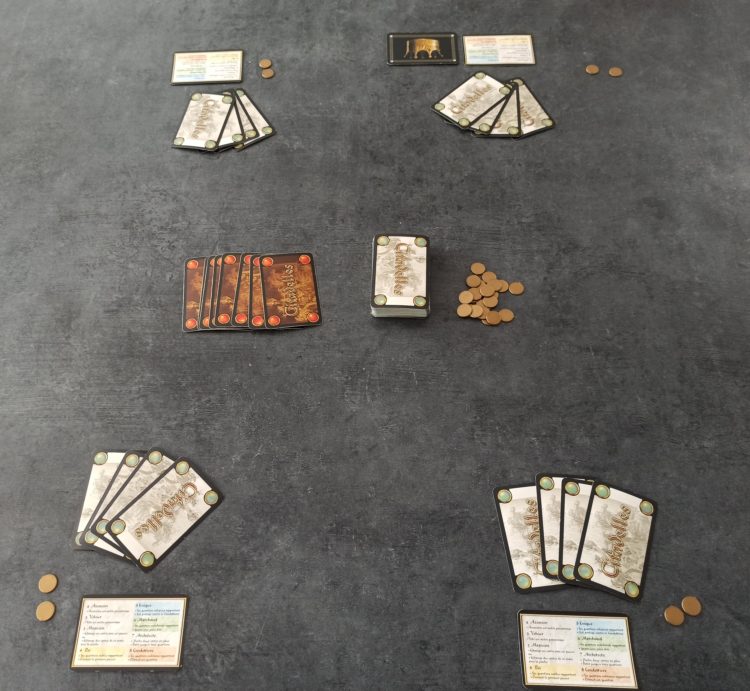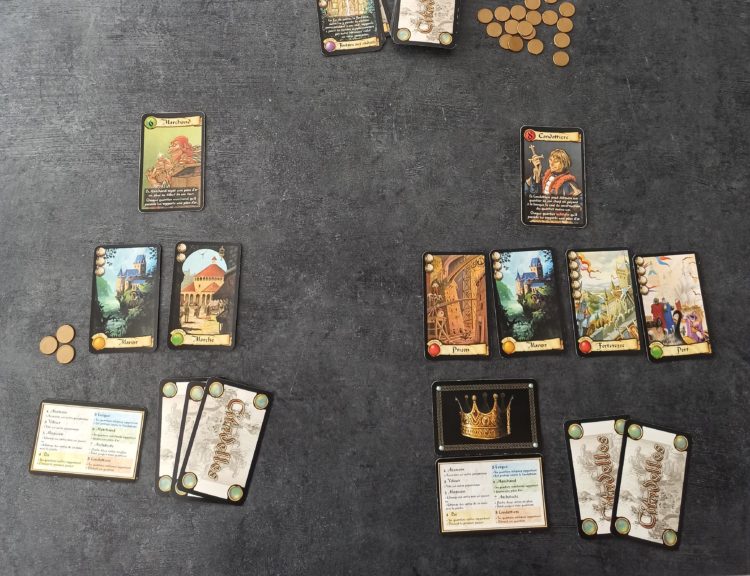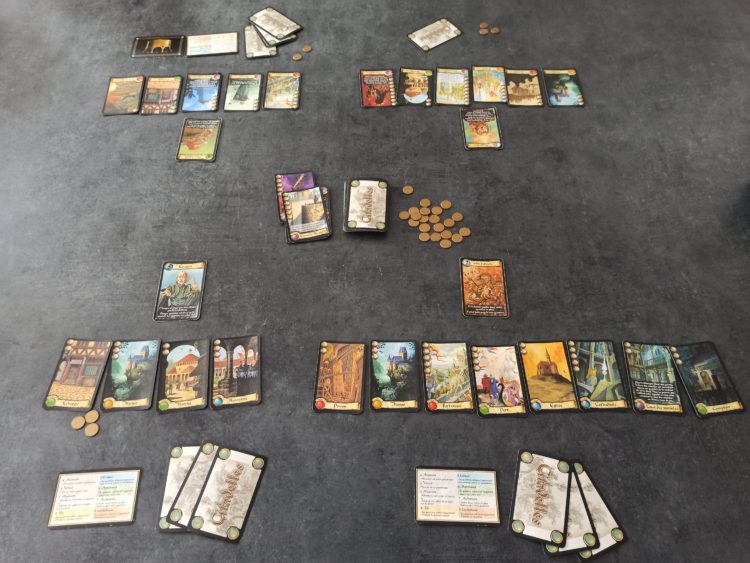
OBJECTIVE OF CITADELS: The objective of Citadels is to build the most prestigious city.
NUMBER OF PLAYERS: 4 to 7 (for the classic game)
MATERIALS: 67 district cards, 8 character cards, 7 game help cards, 1 crown card and 30 gold coins
TYPE OF GAME: Role card game with bluff and dirty tricks
AUDIENCE: Teen, Adult, 10+
OVERVIEW OF CITADELS
Each player is at the head of a city that he must develop. The districts of the cities are represented by cards. Players assume the role of various characters to scheme against their opponents and make their city richer and more prestigious.
SETUP
Each player receives four district cards, two gold coins and a game help card. One player, drawn at random, receives the “Crown” card.

GAMEPLAY
Course of a game round
Each round consists of two distinct phases. First, the players, in a clockwise direction and starting with the player who has the crown card, choose a character. Each player then takes his turn, in the order of the numbers of the characters.
1- Choice of characters
The eight character cards are shuffled, face down. Then a number of them are discarded, some of them face down, some of them face up, and will not be used this round. From the remaining cards, players can choose their character for this round.
The player who has the crown takes the remaining character cards, secretly chooses one and puts it face down in front of him. He then passes the deck of character cards to his left neighbour, who does the same, and so on. When the last player has taken one of the last two cards, he places the remaining card face down with the cards discarded at the beginning of the round.
| number of players | cards discarded face up before character selection | card discarded face down before character selection | card discarded face down after character selection |
| 4 | 2* | 1 | 1 |
| 5 | 1* | 1 | 1 |
| 6 | 0 | 1 | 1 |
| 7 | 0 | 1 | 1** |
* The King must not be among the cards discarded face up. If the King is drawn, it is immediately replaced by another card. There is no issue with the King being the card discarded face down.
** At 7 players, the last player, to the right of the King, receives only one character card. He then takes the card discarded by the first player, chooses one of the two cards and discards the other one face down.
2- Players’ turns
The player with the crown is responsible for calling the characters, in the order of their numbers. Each time a character is called, the player who had chosen it reveals his character card, takes his turn and puts his character card in the discard. If no one had chosen that character, the next character is called.
Players therefore take turns, not in the usual clockwise direction, but in an order that depends on the character cards they have chosen. When all players have played, the eight character cards are taken and shuffled to the next round.
When a player’s character is called, he takes his turn as follows:
– First, he must choose one of the following
- take two gold coins from the bank
- draw two district cards, choose one and discard the other
Notice: Other cards that a player may have to draw (for example, if he is an Architect or a Wizard) are taken directly from the deck, without the possibility of choosing.
– He can then place one of his district cards in his city (in front of him) by paying to the bank the cost indicated on the card. A player should never have two identical districts (two castles, two markets, etc.) in his city.
– Last but not least, each character has a special power that can be used during the player’s turn.
Powers of the characters:
1- Assassin: You announce which other character you murder. The player who has this character must neither react nor declare himself when his character is called. He will only reveal his card at the end of the turn, to announce that he has been murdered and has therefore passed his turn.
2- Thief: You announce which other character you are stealing. When the player who has this character is called and reveals himself, you will take all his gold coins. The Thief can steal neither the Assassin nor the murdered character.
3- Magician: At any time of your turn*, you may choose one of the following:
– exchange all the cards in your hand (not those of your city!) for all the cards in another player’s hand (you can do this even if you don’t have any cards in your hand, and you then take the other player’s cards).
– place a certain number of cards from your hand under the deck, and draw the same number of cards in exchange.
4- King: You receive one gold coin per noble district (yellow) in your city*. You immediately take the Crown card. From the next turn, you will be the one to call the characters and to choose your character first. If no player has chosen the King, the previous king retains the crown. If the King is assassinated, he passes his turn just like any other character. However, after all other players have played, when he announces that he was the assassinated King, he takes the crown card.
5- Bishop: You receive one gold coin per religious district (blue) in your city*. You also are protected from the attacks of the Condottiere.
6- Merchant: In addition to your choice between receiving two gold coins and drawing a card, you receive an extra gold coin. You also receive one gold coin per commercial district (green) in your city*.
7- Architect: In addition to your choice between receiving two gold coins and drawing a card, you draw two additional district cards. You may also build up to three districts during your turn.
8- Condottiere: You receive one gold coin per military district (red) in your city. At the end of your turn, you can attack a city to destroy a district of your choice. You can destroy a district of cost 1 for free, or you can destroy a district of higher cost by paying its cost minus one (1 coin for a district costing 2 to build, 2 coins for a district costing 3, etc…). The Condottiere can even attack his own city. The Condottiere cannot attack an already finished city which has eight districts.
* These actions can be performed at any time during the player’s turn, at his discretion. For example, a player may take the income from his districts before building (if he needs money to build) or after building (if the new district earns him money). However, all district revenues must be collected at one time. A player who has taken them before building will not be able to receive income for the district he is building this turn.

END OF GAME
When a player builds his eighth and final district, other players play their turn and the game is over. Each player counts his points as follows:
- Total construction cost of the city’s districts
- + 3 if the city includes districts of the five different colours.
- + 4 for the first player to put down his eighth district
- + 2 for other players with eight districts
Enjoy!

VARIATIONS
Shorter games: Play in seven or even six districts, not eight. This is particularly suitable for 6 or 7 players unless you like long lasting games.
- Comprehensive Guide to the Board Game Go (weiqi, baduk) - January 23, 2024
- Are Creative Suites Changing Gaming - October 30, 2023
- How Classic Games Have Been Reimagined for Modern Audiences - October 5, 2023